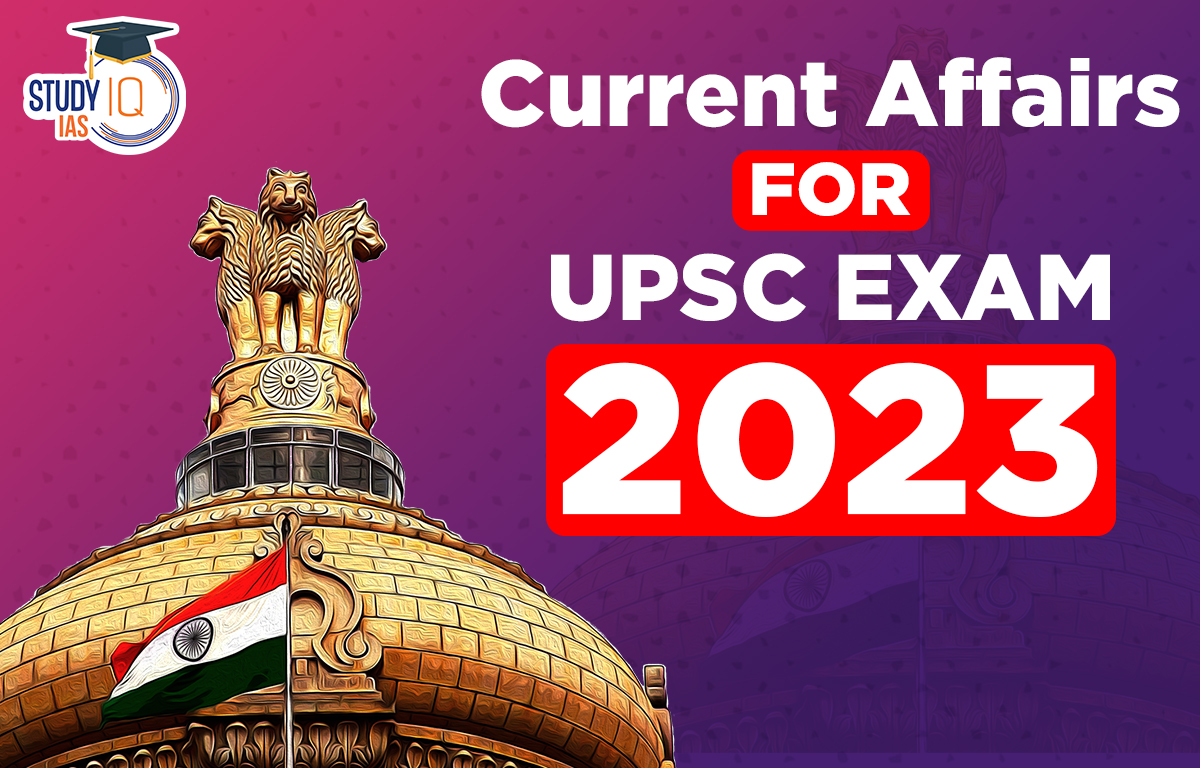Current Affairs 26th April 2023 for UPSC Prelims Exam
Rule of law Index
Context: Recent incident of killing of a gangster in police presence raises questions about rule of law in Uttar Pradesh.
About Rule of Law
- As per United Nations (UN), the rule of law “is a principle of governance in which all persons, institutions and entities, public and private, including the State itself, are accountable to laws that are publicly promulgated, equally enforced and independently adjudicated, and which are consistent with international human rights norms and standards”.
- World Justice Project (WJP) lays out four broad outcomes, if the rule of law prevails in a country.
- Accountability: Implying that the government as well as private actors are accountable under the law.
- Just Law: Implying that the law is clear, publicised, and stable and is applied evenly. It ensures human rights as well as property, contract, and procedural rights.
- Open Government: Implying that the processes by which the law is adopted, administered, adjudicated, and enforced are accessible, fair, and efficient.
- Accessible and Impartial Justice: Implying that justice is delivered timely by competent, ethical, and independent representatives and neutrals who are accessible, have adequate resources, and reflect the makeup of the communities they serve.
Rule of Law Index
- World Justice Project (WJP) measures people’s perceptions and experiences of the rule of law in 140 countries and jurisdictions.
- Index values range between 0 and 1 with 1 being the score for complete adherence to the rule of law.
- India’s overall score in the 2022 report is 0.5 and its global rank was 77 out of 140 countries.

Indicator Used for Rule of law Index by WJP
- Constraints on government powers: This includes things like how effectively does the legislature or the judiciary deal with the government.
- Absence of corruption: This essentially ascertains if public offices are being used for private gains.
- Open Government: This includes things such as the right to information and laws and government data, which are well publicised.
- Fundamental rights: This also includes whether the due process was followed.
- Order and security: Whether crime is effectively controlled and civil conflict limited etc.
- Regulatory enforcement: Things like whether regulations are effectively enforced etc.
- Civil justice: Includes factors such as whether people can afford and access civil justice,
- Criminal justice: Includes factors such as whether due procedures are followed etc.
Current Affairs 25th April 2023 for UPSC Prelims Exam
Misinformation Combat Alliance (MCA)
Context: Central government has given it nod to the Misinformation Combat Alliance’s (MCA) proposal to set up a self-regulatory organization (SRO) to vet fact-checkers for non-government-related news.
About Misinformation Combat Alliance’s (MCA)
- MCA is an alliance of media companies set up in March 2022 to combat misinformation and build tools to aid fact-checking.
- Membership in the MCA is open to any organization that applies.
- It is currently a network of 14 digital publishers which includes publications such as Boom Live, Factly, The Logical Indian, Vishwas News and The Quint.
- The Misinformation Combat Alliance has approached the government to act as a self-regulating body to flag fake news online in line with the IT Rules, 2021.
- MCA’s proposal is to regulate misinformation that is unrelated to the Union government, which is reportedly due to the Centre’s unwillingness to hand this mandate to an international network like the International Fact Checking Network (IFCN).

Manamadurai Pottery Gets GI Tag
Context: Manamadurai pottery recently earned a Geographical Indication (GI) tag.
About Manamadurai pottery
- Manamadurai in Sivagangai district of Tamil Nadu is known for pottery making.
- Materials used: The main raw materials for making these pots are soil and water. Vaigai river enriches the clay used for the Manamadurai pottery.
- A unique type of clay is sourced from water bodies like Nedunkulam, Nathapurakki, Sundaranadappu, Seikalathur to make these pots.
- The sand, collected from different places of the district, is used for making pottery and dried for two days.
- The particles of the mud get separated by sieving.
- Preparation: The slurry is mixed with the sand and lead and graphite are added to the mixture to improve the quality.
- This mixture is rich in calcium lime, ash, red lead, sodium silicate, manganese, iron, and plasticizing.
- The pot is painted in different colours. The circumference of the pot and the neck are proportionate so that the pot sits flat on the ground.

About Geographical Indications (GI)
- GI tag have been used a certification that the product is produced as per traditional methods and has a particular reputation because of the geographical origin.
- Generally, the GI tags are used for industrial products, foodstuff, agriculture products, spirit drinks, and handicrafts.
- GI Tag ensures that no one other than the registered authorized user is allowed to use the name of the popular Product.
- The Geographical Indications of Goods (Registration and Protection) Act, 1999 seeks to provide for the registration and better protection of geographical indications relating to goods in India.
- It is governed and directed by the WTO Agreement on Trade-Related Aspects of Intellectual Property Rights (TRIPS).
Urea
Context: Recently, sales of urea crossed a record 35.7 million tonnes (mt) in the fiscal year ended March 31, 2023.
About Urea
- Urea is a chemical nitrogen (N) fertiliser, white in colour, which artificially provides nitrogen, a major nutrient required by plants.
- India is the second-largest consumer and the third-largest producer of urea in the world.
- India consumes around 33 million tonnes of urea annually, of which almost 70% is domestically produced and the rest is imported from other countries.
- Most farmers prefer urea as fertilizer in India because other non-urea varieties like Di-Ammonium Phosphate (DAP), Muriate of Potash (MOP) etc. are expensive.
- Higher cost also leads to excessive use of urea and adverse impact on crops.
- It has an efficiency of about 25 per cent.
- It fails to have the desired impact on crops as it is often applied incorrectly, and the nitrogen in it is vaporised or lost as gas.
- A lot of nitrogen is also washed away during irrigation.
Steps taken by Government to Reduce Urea Misutilisation
- Nutrient-Based Subsidy (NBS): The government fixed a per-kg subsidy for each fertiliser nutrient: Nitrogen (N), phosphorus (P), potash (K) and sulphur (S).
- Neem-coating: In 2015, the Centre directed all manufacturers and importers to do neem-coating of the urea supplies.
- The underlying premise was that this would render urea unusable for industrial purposes and hence, diversion would be curbed.
- Aadhaar authenticated invoice: In March 2018, the government implemented a decision requiring retailers to generate an Aadhaar authenticated invoice and sale being registered on a point-of-sale (PoS) machine.
- The manufacturers were to get the subsidy only on submission of this electronic proof of sale.
- Cap on bags per transaction: In August 2020, the Centre restricted purchase of urea to 100 bags per transaction, down from 999 bags.
- It also wanted states to cap the number of such transactions by a purchaser in a month.
- Caps per season: The government now wants to cap the number of bags of subsidised fertilisers that a farmer can buy for the whole season.
- This cap is to be calculated based on the nutrient requirement linked to land holding, crops grown, etc.
PM CARES Fund- Accountability and Transparency
Context: The PM CARES Fund’s lack of transparency, coupled with its exemption from public audits and exclusion from the purview of the Right to Information Act, has sparked controversy yet again.
About the PM CARES Fund:
- The Prime Minister’s Citizen Assistance and Relief in Emergency Situations Fund (PM CARES Fund) was created as a dedicated fund in March 2020 (and registered as a Public Charitable Trust), following the COVID-19 pandemic in India.
- The stated purpose of the fund is for combating, containment and relief efforts against the coronavirus outbreak and similar emergency or distress situations in the future.
- The fund is administered on an honorary basis by a Joint Secretary (Administration) in the Prime Minister’s Office (PMO) as Secretary to the fund.
Funding of PM CARES Fund:
- PM CARES accepts domestic and foreign donations. starting from Rs. 10, the smallest denomination. Government controlled Navratna and Mini Ratna PSUs are the principal donors.
- PM CARES Fund also accepts contributions made out of Public Sector Undertakings.
- It also must be noted that PM CARES Fund is a government funds not sustained by any budgetary support; thus, the contributions are not included in the Consolidated Fund of India.
- Any Corporate donations is accounted for as Corporate Social Responsibility (CSR) expenditure.
Accountability Issues Faced by PM CARES Fund: Ever since its establishment, the PM CARES Fund has been a target for the opposition parties who keep questioning its legibility of the Fund.
- Even though the Fund has the Prime Minister as the head along with other important ministers as Trustee members, it is still claimed to be a public charity fund.
- It also exempts any foreign contribution to the Fund from FCRA (Foreign Contribution Regulation Act).
- It accepts contributions from Public Sector Undertakings, uses government infrastructure and national emblem, the Fund keeps it ambiguous whether it is included within the ambit of the RTI Act or not. The Government initially claimed that the fund is a private fund and is outside the purview of the Right to Information (RTI) Act 2005.
- Later, the Government reversed its stance, admitting that the PM CARES Fund was a public fund but still refusing to disclose information about it under the RTI Act.
- The total amount donated and the names of donors have not been made public, and the fund is being audited privately. The issue that has been raised is that only Rs. 3,976 crores of the total Rs. 10,990 crores have been spent between the period of 27th March 2020 and 31st March 2021. This is only 36% of the total amount.


 World Population Day 2025, Themes, Histo...
World Population Day 2025, Themes, Histo...
 What are Polycyclic Aromatic Hydrocarbon...
What are Polycyclic Aromatic Hydrocarbon...
 Marlin Fish: Species, Features, Appearan...
Marlin Fish: Species, Features, Appearan...





















